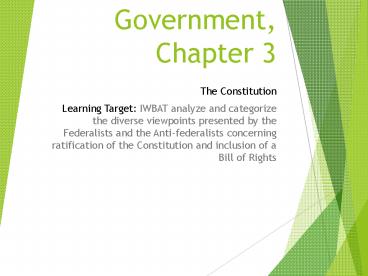Government, Chapter 3 - PowerPoint PPT Presentation
1 / 22
Title:
Government, Chapter 3
Description:
Government, Chapter 3 The Constitution Learning Target: IWBAT analyze and categorize the diverse viewpoints presented by the Federalists and the Anti-federalists ... – PowerPoint PPT presentation
Number of Views:230
Avg rating:3.0/5.0
Title: Government, Chapter 3
1
Government, Chapter 3
- The Constitution
- Learning Target IWBAT analyze and categorize the
diverse viewpoints presented by the Federalists
and the Anti-federalists concerning ratification
of the Constitution and inclusion of a Bill of
Rights
2
Flashback
- Why did the founding fathers decide to write a
constitution to replace The Articles of
Confederation?
3
Structure and Principles
- Structure- only 7,000 words
- Preamble- introduction, why it was written.
- Articles-
- 1- Legislative branch Make Laws
- 2- Executive branch Carry out and enforce laws
- 3- Judicial branch Rule on Constitutionality of
laws and actions
4
Structure
- Articles continued
- 4. Relationships between States
- 5. Amendments
- 6. Supremacy clause- The Constitution, Laws
passed by congress, and Treaties are the supreme
law of the land. - 7. Ratification- 9 of 13 States needed.
- Amendments- 27 in all, first 10 are the Bill of
Rights
5
Major Principles
- Constitution Based on these concepts
- Popular Sovereignty
- Federalism
- Separation of Powers
- Checks and balances
- Judicial Review- Marbury v. Madison 1803
- Limited Government
6
Section 2 3 Branches of Government
- Legislative Branch
- House- The voice of the people.
- Expressed/enumerated powers
- Article 1, section 8, pgs 779-780.
- Elastic clause- necessary and proper to carry
out expressed powers - McCulloch v. Maryland, 1819, Implied powers
7
Checks and Balances
- Impeachment- House accusation of federal official
- Over ride of veto- 2/3rds
- Senate confirmation of Presidential appointments
8
The Executive Branch
- A new branch developed
- Very vague powers initially
- 10 specific powers listed
- Commander in Chief
- Pardons
- Appointments
- Treaties
9
Presidency Now and Then
- No partiality in hiring
- Quit after 2 terms.
- Executive agreements used more often. No
Congressional approval needed.
10
Judicial Branch
- Appears to be the weakest.
- Supreme Court set by Constitution.
- All lower courts set by Congress
- Federal and State courts each have their own
jurisdiction.
11
Jurisdiction
- Who hears a case
- Supreme Court Original Jurisdiction
- U.S. Laws
- Treaties with foreign nations
- Interpretations of the Constitution
- Bankruptcy cases
12
Then and now
- Did not even have a building.
- Had to ride circuit, travel to hear cases when
not in session. - John Jay the 1st Chief Justice
- Marbury v. Madison, 1803, elevated their status
to equal among the three branches.
13
Section 3 Amending the Constitution
- Ratified, or approved, in a number of ways.
- Proposed by 2/3 of Congress and ratified by ¾ of
State Legislatures. 26 of 27 amendments. - Proposed by 2/3 Congress and ratified by ¾ State
conventions. 1 time
14
Amending the Constitution
- Constitutional convention never used.
- Equal Rights Amendment- questions because states
revoked their ratification. - Congress decides which method the states use and
time. Modern times is 7 years to ratify
15
Informal changes
- Through Law- Laws can clarify or expand certain
powers. - Tax codes expanded ability to tax.
- Through Practices
- Impeachment- Clarify what high crimes and
misdemeanors are.
16
Informal Presidential Changes
- Presidential Succession
- 25th amendment, 1967 officially set succession.
- Foreign Affairs- Executive agreement used more
than treaties today. - Domestic affairs- Legislation initiated by the
President
17
Court Decisions
- Judicial Review
- Judicial restraint- Do not take the initiative.
- Judicial activism- court should play a role in
shaping policy - Chief Justice Earl Warren, from 1953-1969, took
on many controversial cases.
18
27 Amendments
- 1st ten are the Bill of Rights
- 1st- Freedom of Speech, religion, press,
assemble, and petition (Appeal to Congress). - Within limits- slander and libel
- 2nd- Keep and bear arms
- 3rd- Prohibits the quartering of soldiers in homes
19
Bill of Rights
- 4th- Search warrants, probable cause
- 5th- Grand jury, Double jeopardy, self
incrimination, and eminent domain - 6th- Speedy trial, change of venue, and lawyer
20
Bill of Rights
- 7th- Jury trial
- 8th- excessive bail, excessive fine, and cruel
and unusual punishment - 9th- All rights retained by the people.
- 10th- States rights
21
Amendments
- Civil War Amendments- 13-15
- Suffrage Amendments (The right to vote)- 15-
African Americans, 17- Vote for Senators, 19-
Women, 23- Washington DC, 24- Poll tax, and 26-
18-20 year olds
22
Assessment
- Explain how the views of the Federalists and
Anti-Federalists were included in the
Constitution - Honors Do you believe that the 3 branches still
have equally shared power? Explain your answer
using examples from current events. - Homework Read short explanation about The
Federalist papers http//www.history.com/topics/f
ederalist-papers































